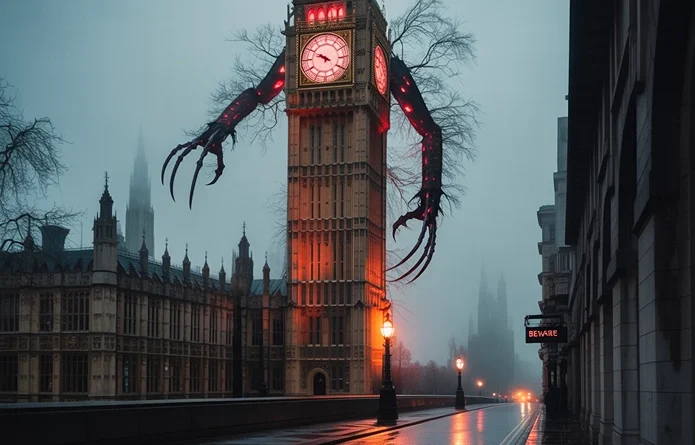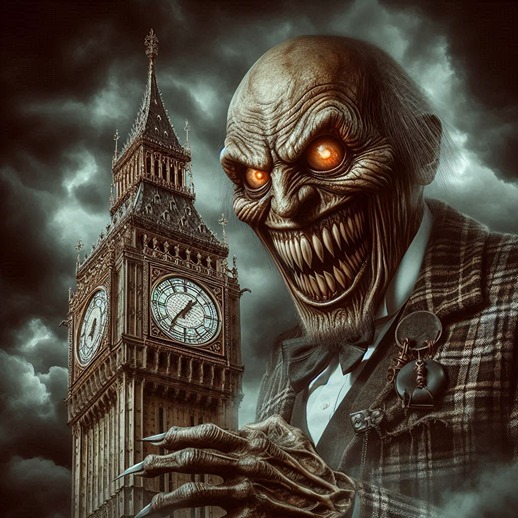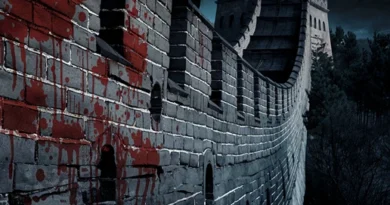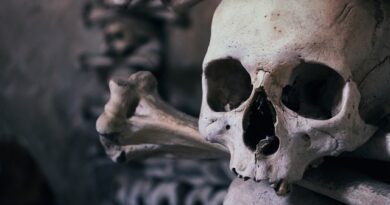Holly Clock! It’s Time To Present Some Scary Facts About Big Ben
If you visit London, you can’t miss it. Almost every tourist who comes to the capital of England sees it and takes a picture of it, even though it is supposedly “just” a clock tower, and it is not possible to visit it except in very special cases. Big Ben is one of the undisputed symbols of London, an iconic symbol of the city and the British Kingdom in general.
Big Ben is much more than a clock tower; it also has scary sides, which probably interests us here in Horror World. Its history is very long and includes unusual events, accidents, and some acts of violence over the years. Those who believe in myths and ghost stories will claim that Big Ben is also haunted to some extent.
It’s time to read facts about Big Ben: from basic facts through its cultural influence to scary stories.
What Is Big Ben? (Spoiler: A Bell, Not A Clock)
As we know, Big Ben is a giant clock in the clock tower of the Palace of Westminster in London, aka the British Houses of Parliament. It has a few more names, like The Great Bell or The Great Clock of Westminster, but they are less common. The tower is part of the Palace of Westminster complex and is considered one of the most distinctive symbols of London and British parliamentary democracy.
In practical terms, only the clock itself should be called “Big Ben,” or even in the original meaning – only the large bell at the top of the tower initially received this obligatory name. At some point, they realized that the clock itself was much more impressive and iconic than the bell in it, and they decided to appropriate the obligatory name for it unofficially.
👻 London Is Waiting to Scare You 👻
Book tickets for the scariest experiences in London:
🩸 Disclosure: Some links are affiliates. It helps keep our site alive 👻
Since 2012, we have known the tower as the “Elizabeth Tower.” The name was given to it to mark the 60th year of reign (“Diamond Jubilee of Queen Elizabeth II”) of Elizabeth II in the United Kingdom and the Commonwealth. The clock expresses the connection to the Queen of England in several ways. On it, you will find words in Latin that mean: “O Lord, keep safe our Queen Victoria the First.”
Along with the central bell that gave it its name, Big Ben has four smaller (and lighter) bells that produce other sounds: the first quarter bell plays “Sol,” the second plays the sound “Fa,” the Big Ben bell itself and the third quarter bell play “Mi” and the fourth and the quarter bells play “Ti.” The main principle is that you will hear four sounds 15 minutes after the big hour, and every quarter of a year after that, the existing section and four “new” sounds. Therefore, the clock produces the complete melody at every big hour, which includes 16 sounds. After that, the clock produces additional sounds, indicating the specific time (five sounds to indicate 5:00).
💀 Killer Deals & Scary Recommendations 💀
🎭 Costumes & Accessories
HalloweenCostumes Fun Costumes Entertainment Earth
🛒 Online Shopping
AliExpress Amazon Walmart Etsy
🧛 Collectibles & Horror Brands
Funko Hot Topic Lego Spirit Halloween
🎢 Attractions & Tours
GetYourGuide Tiqets Viator Klook
📖 Blogs & Horror Sites
Bloody Disgusting iHorror Fangoria
🩸 Disclaimer: Some links are affiliate links. The price stays the same – it just helps keep the site alive 👻
Who Built Big Ben?
The history of the world-famous clock began in the 19th century when it was first built on the site of the old palace clock tower. The old clock tower was destroyed by fire in 1834. Work on the tower began in 1843 and was completed only in 1859. The Big Ben was manufactured by the Hughes Company, which is responsible, among other things, for the Liberty Bell of the United States, located in Philadelphia.
Building a tower of this size in the 19th century was a complex task, especially when raising such a heavy bell to such an impressive height. The first bell cracked badly, and there was no choice but to replace it with a slightly lighter (but still very heavy) one. Raising the bell took about 30 hours while tilting it sideways rather than vertically, making it easier to transport. The bell also cracked during this task, but fortunately, it was a relatively small crack that did not affect the ongoing operation of the bell.
The clock mechanism, designed by the famous English watchmaker Edward John Dent, is particularly complex and considered years ahead. Among other things, it includes using a special chalk system for accurate time measurement.
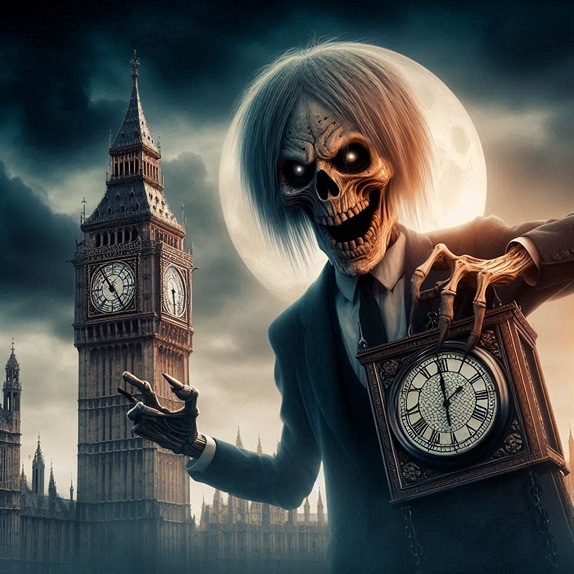
What Does Big Ben Look Like?
The clock has a Neo-Gothic style, which is in line with the main characteristics of architecture in Victorian England. On top of the tower, you will find Gothic-style elements, including the upper end, reminiscent of the bell towers of cathedrals built in this style. British Architect Charles Barry and his assistant Augustus Pugin are responsible for the clock’s impressive design. They realized very early they had to place the tower’s foundations deep in the ground to maintain stability, given its enormous weight.
The clock results from a collaboration between first-class artisans and engineers, each of whom contributed their style. The chief architect, Charles Barry, was known then for his magnificent designs and ability to solve even the smallest details. He designed some of the most important buildings in England at the time, such as the nearby Palace of Westminster. He is considered one of the pioneers of the Italianate architectural style that developed in the Land of the Boot in the 16th century and reached Western Europe and the United States in the following centuries. Augustus Pugin contributed his expertise in the Gothic architectural style
How Heavy Is Big Ben?
The Big Ben bell is large and massive, weighing about 13,760 kg, or more than 13 tons. The simple reason is that the various elements that make up the clock are heavy by any standard. The hour hand alone weighs about 300 kg and is made of heavy metal, which is used, among other things, to make guns. Today, the hand’s length is about 2.7 meters, which is a little longer than the clock on the walls of your house.
The minute hand is even longer – about 4.5 meters! It is now made of copper after it was also originally made of iron. The iron was too heavy for the iron bells to move around the clock (literally), and only after the replacement, sometime in 1859, did the clock hands manage to push for the first time. Incidentally, the sound is not produced by swinging the bells but by striking them from the outside with giant hammers. Since the replacement of the bell, the tower has been slightly lighter. Still, the total weight of the bell is around 12 tons.
Who Is Big Ben Named After?
Although “Big Ben” sounds a bit like the name of a porn actor, the origin of the name is probably completely different. According to the first, more accepted version, Big Ben was named after Sir Benjamin Hall, the Minister of Works at the time, and was therefore in charge of the clock’s installation in 1859. This Benjamin Hall was a very massive and tall man (over 1.93 meters) and probably also had relatively aggressive behavior, which supposedly gave him the nickname “Big Ben.”
The nickname was immediately transferred to the clock that he was responsible for building, as the foreman of the work, and was maintained over the years – even after only one year after the installation, when Hall was no longer in office, the bell cracked severely, and they had to replace it.
Another version is that the tower was named after Benjamin Caunt, the world heavyweight boxing champion. The boxer got the nickname “Big Ben” to glorify him, and the name was also borrowed from the tower to indicate its impressive dimensions in the London landscape.
How Tall Is The Big Ben?
Big Ben rises to a height of about 96 meters, which means that in practical terms, its height exceeds 11 floors. If we want to speak in “London” terms, Big Ben is about the height of 21 London buses standing on each other.
Reaching the top of the tower requires climbing 334 steps, which is unfortunately not available to the average tourist. The challenging journey to the top of Big Ben involves climbing just under 300 steps, bringing you to the clock faces. Then, about 40 more steps lead to where the bell hangs, and about 60 more steps lead to the top of the tower.
There Is Also A Little Ben
Suppose you prefer a smaller and much less impressive version of the tower. In that case, you can reach the other end of the street: the intersection of Vauxhall Bridge Road and Victoria Street, also in the Westminster neighborhood. There, you will find “Little Ben,” a clock tower that is essentially a miniature imitation of Big Ben.
Little Ben was erected in 1892 in a different location after being dismantled in 1964 and moved to its current location in 1981. It is strange that this clock is only accurate for six months because the time in Britain is precise only when it is summertime, while during the rest of the months, the clock shows the time in France. The reason is that the clock was moved with the funding of a French company to symbolize the friendship between the two countries.
There’s A Lot Of Glass Here
Big Ben contains glass in commercial quantities. Each face includes 325 pieces of opal glass, also known as “white glass,” held together by a cast-iron frame. If you factor in the fact that there are four faces, that’s an astronomical 1,292 pieces of glass.
The clock’s construction also uses other high-quality materials – some quite unusual – such as limestone from Portland Island in the English Channel and locally sourced bricks.
At times, the clock’s face glows with a soft white light, adding to its mystique. This illumination indicates that the British Parliament is in session.
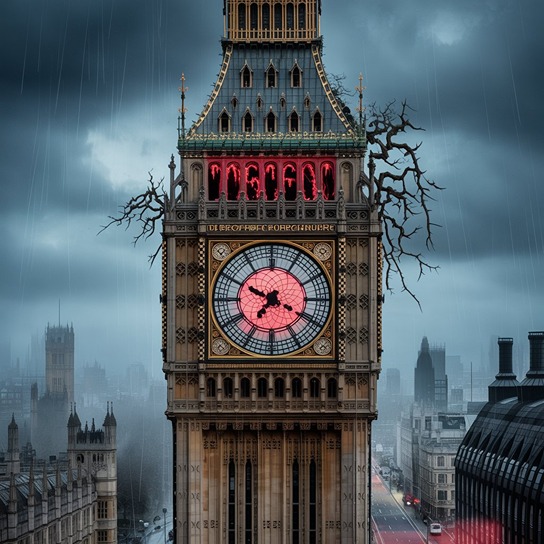
The Big Renovation Of Big Ben
Unusually, Big Ben has remained intact and functioning properly since the 19th century. It has survived several disasters, including World War II. In one memorable incident from the war, German bombs destroyed the British House of Parliament, but the damage to the clock tower was minimal and did not stop it from ringing.
The hands of Big Ben continued to move most of the time, but sometimes, there was no choice but to stop to improve the situation. In August 2017, the British Parliament realized there was no choice but to renovate the clock tower massively, which would cause the clock to stop working for several years until at least 2021.
The renovation of Big Ben got underway and reached astronomical amounts, estimated in 2020 at about 80 million pounds and probably exceeded the 100 million mark (the original budget was only about 50 million pounds). In September 2020, the removal of the scaffolding began, and it was not until April 2022 that the scaffolding was removed. The clock got a refreshing look just in time for the next important milestone in the kingdom’s history: the platinum jubilee of Queen Elizabeth II (i.e., 70 years of reign) in June of that year.
For about five years, the bell fell silent, an unprecedented fact in its history. During these years, among other things, Britain withdrew from the European Union (“Brexit”), and no less than three prime ministers changed. Queen Elizabeth passed away after countless years at the head of the kingdom, being replaced by Charles.
The Leaning Tower Of Pisa, Behind You
When talking about crooked buildings in the world, the first name that comes to most people’s minds is the Leaning Tower of Pisa, whose we addressed its frightening sides (and there are some) in a separate article on the site.
It turns out that Big Ben is also leaning slightly, and the reason is surprising: the famous London Underground system, The Tube, whose movement causes vibrations in the area, including the ground on which the tower stands. This happened mainly in the run-up to the 2012 London Olympics when work on the Jubilee Underground line took place right under the clock tower.
In the early 1990s, the persistent rumor became a fact: Big Ben was getting more crooked. Over the years, it has moved about 48 cm, so at that time (2011), it was leaning about 0.26 degrees – about one-sixth of the leaning of the Leaning Tower of Pisa. It may sound trivial, but engineering experts say it is a problem that needs to be solved, especially given that the tower’s tilt has caused cracks in the walls of the nearby British Parliament building. According to one expert, if structural issues remain unresolved, the tower could eventually topple or crash into the Parliament building – though not for another 5,000 years.
Even An Ancient Clock Is Wrong By A Few Seconds
Moving on to August 2015, a rather strange fault was discovered with the clock: for several weeks, it simply rang 6 seconds too early. The fact that the clock was running a few seconds too fast disrupted the BBC radio broadcasts, which broadcast the bells ringing live every hour.
The best clockmakers in the Houses of Parliament tried to solve the problem. They concluded that the disruption in the operation was mainly related to the clock’s extreme age. Or, as one of the clockmakers put it: “It has a fault here and there. It’s a bit unstable.”
Since this is an ancient clock, it is clear that the treatment was also done by traditional means. The clockmakers of the British Parliament use old pennies to regulate the clock’s operation: that is, they load or remove coins from the clock’s pendulum, which causes it to slow down or speed up if necessary. After a few days of work, the clockmakers managed to maintain Big Ben’s accuracy. To this day, there is still a need for adjustments of this kind several times a week to maintain accuracy.
In 1980, BBC Radio announced that the clock would become digital and receive the cool name “Digital Dave.” What is essential to know in this context is that the announcement date was April 1, 1980, so this announcement was a bad joke and probably not very funny either.
Can You Visit Big Ben?
Most tourists are content to see Big Ben from a distance and take pictures of it. Suppose you still want to go inside the clock. In that case, you can try signing up for a 90-minute guided tour that will take you up the clock tower – yes, up all 334 of its steps – while learning about the history of the tower, its uniqueness, and the wildly ambitious conservation project that has been carried out here. The tour will allow you to see exactly how the clock mechanism works From its inside, hear the bell from a touching distance, and more.
In addition to the high demand for tours, and their supply is relatively low, they are also unsuitable for everyone. The main difficulty is climbing several hundred steps (although, in certain situations, you can book an accessible tour), and the sights you see along the route seem pretty boring. Perhaps for these reasons, the tour is only suitable for those aged 11 and up.
The most accessible and simplest option to learn about Big Ben is simply through a guided tour, which passes through the area or observes it from a distance: a bus tour or even a cruise on the Thames. In this case, you will be satisfied looking at Big Ben and not going inside, but many tourists will argue that this is enough.
The King Of London’s Selfies
Unlike other important tourist sites, such as the Eiffel Tower or the Leaning Tower of Pisa, visiting the Clock Tower is not the main attraction. Previous All, because it is usually a very complex task, often even impossible. You can see the tower from many points in London, especially since right next to it, you will find some of the must-see sites of the English capital, such as the Houses of Parliament, the Palace of Westminster, and newer attractions that are (also) suitable for family fun, such as the London Eye, the Aquarium, and even a cute attraction based on Shrek.
In the 21st century, being near Big Ben and not having your picture taken seems impossible. Every tourist who has visited London probably has a few photos in their catalog of them standing with the tower in the background, and as is tradition today, a large part of these photos are selfies. At least, as long as the building is still relatively straight, we don’t get silly pictures of people pretending to lift the tower or have sex with it, at least for now.
Is Big Ben Haunted?
Big Ben is a historic building in a city full of secrets and history, as dark as London. If you connect the dots, it’s easy to see why Big Ben has its own horror stories and myths. One of the more common myths, which won’t surprise you if you’ve read our previous reviews of spooky historical sites, is that the ghost of Benjamin Hall is still in Big Ben, roaming the tower and continuing to watch over it.
Another theory that comes up occasionally is that Big Ben has ghosts because Westminster Palace has a long and sometimes turbulent history. Political struggles and social changes have supposedly left their mark on the entire complex in the form of an unusual energy found within it or something of that nature.
We mentioned earlier that the giant clock has been acting strangely for certain years. Some would blame its age or complex mechanism, but some believe this change means something else: the clock’s ability to predict disasters and other terrible events. According to those same people, if Big Ben is ringing at an unusual time or irregularly, something horrible is about to happen. There are stories about several historical events that occurred shortly after there were malfunctions in Big Ben. I have not found verification of this story or an explanation for these terrible events, so take the claims made in this paragraph with limited liability.
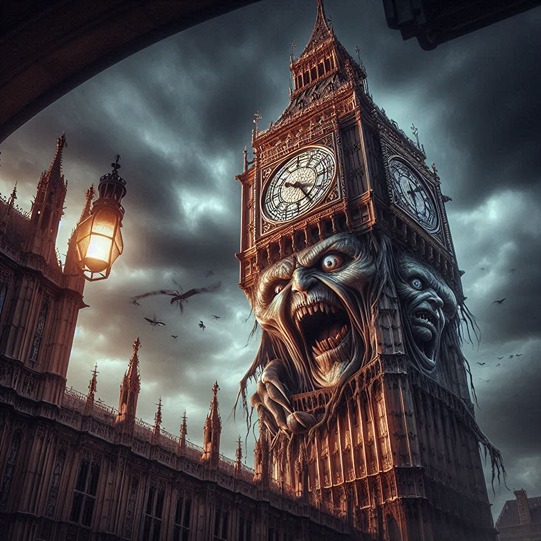
Big Ben Was Stolen. Wait, What?
In March 2025, we recently heard about a pro-Palestinian person who set out on an extraordinary mission. He climbed Big Ben in London and stayed there for about 16 hours to deliver a message. For some reason, he decided to climb barefoot, which made his feet bleed, held the Palestinian flag in his hand, and shouted something about the liberation of Palestine Blah Blah Blah, if I understood correctly.
He paralyzed traffic in central London for several hours, mainly on Bridge Street. In the end, he agreed to comply with the police’s request and descend from the tower on his initiative and not jump from it to his death. Here is a brief coverage of the case from Fox News.
Another video that sparked laughter around the world – at least among those who can see reality in an informed way – was a claim by some Palestinians, Muslims, or whoever centered on a serious accusation: Big Ben was stolen from the Palestinians. A video of a lady with an Arab appearance, in which she claims that Big Ben is “ours, the Palestinians” and that it even came to London from the Jaffa Gate in Jerusalem, sparked laughter. We will not upload it here because it is simply too stupid, and we do not encourage traffic to stupid videos. We will mention the response of an Arab-Israeli journalist and advocacy activist, Yoseph Haddad, who filmed a viral video in London against the backdrop of Big Ben, illustrating the story’s absurdity. “This is the reality, guys,” the “Defender of Israel” concluded. “They lie, and lie, and lie. But you know what’s even sadder? There are uneducated people who actually believe their lies. What a shame!”
Big Ben On The Big Screen
If you’ve ever seen a film set in London, chances are you’ve seen Big Ben in all its glory in one of the scenes, or at least establishing shots. This is no coincidence because it is, after all, one of the most prominent symbols of London, chosen in 2007 as the most iconic London location in cinema. It would be too short to mention here all the films set in London that have included a visual reference to the tower, a shot that usually aims to say, “Here we are in London,” and connect us to the next scene in the city.
Peter Pan Big Ben Scene
Big Ben appeared in very early classic films, such as the scene in the 1956 animated film “Peter Pan,” in which Peter and the Banks family briefly stop on one of the hands of the clock and make it stop before taking off for Neverland. In both versions of “Mary Poppins,” in 1964 and 2018, the flying nanny used her umbrella to fly and land on the hands of Big Ben as well.
The 39 Steps Big Ben Thrill
Alfred Hitchcock’s “The 39 Steps“ from 1935 is a terrific classic spy thriller. However, anyone who has seen it knows that its “39 steps“ do not refer to those of Big Ben but to some spy organization. The plot is based on the book “The Thirty-Nine Steps“ by Scottish author John Buchan, a story that has spawned more than one film version. The version relevant to our case is “The Thirty-Nine Steps“ by Don Sharp from 1978, which added a classic scene on the steps of Big Ben, in which the hero climbs the outside of the clock face to prevent it from setting off a bomb. Incidentally, this idea is based on a similar scene in the 1943 British comedy “My Learned Friend.”
The fact that it is an undisputed symbol of London explains why disaster films depicting apocalyptic destruction have chosen to destroy Big Ben as part of this. The tower has been the subject of several blockbusters over the years, such as “Mars Attacks!“ (1996), the James Bond film “Spectre“ (2015), “London Has Fallen“ (2016,) and even “Harry Potter and the Deathly Hallows“ (2010). Here is a collection of some scenes of destruction and devastation in Big Ben or in London as a whole.
The Big Ben In Horror Movies
From a horror fan’s perspective, it’s hard to argue that a clock is too scary to look at. There aren’t many instances where the main antagonist was a clock, except perhaps when the scary entity was a house that contained a strange clock with a particular mystery (“The House with a Clock in Its Walls,“ of course).
Nevertheless, the clock occasionally stars in horror films. One memorable scene is the mesmerizing opening of Danny Boyle’s excellent 2002 “28 Days Later”. We follow the protagonist, Jim (Cillian Murphy), after he wakes up from a coma in the famous St. Thomas’ Hospital. The stunned Jim wanders the streets of London and discovers it is completely abandoned, which probably has something to do with zombies. We get some breathtaking shots of abandoned London, including Big Ben and the Houses of Parliament complex.
In the world of horror, Big Ben can also be the name of a character. Let’s return to 1985, the first film in the horror comedy franchise “House.“ The first film is about a writer named Roger Cobb (William Katt), who finds himself in a complicated situation after separating from his wife and his son’s disappearance. He inherits an old house from his elderly aunt, who committed suicide in it and spends his time writing a story that describes his experiences from the Vietnam War. The problem is that shortly after, he begins to see horror scenes and tropes from the vast catalog of haunted house films, with one of the most threatening and memorable characters being that of “Big Ben“ – his army buddy during the war who dies in the war, but now returns in a particularly frightening zombie version. There are some similarities here with Stanley Kubrick’s “The Shining“ in the context of war trauma – another theme in many horror films.
So, there may be scarier buildings in London than Big Ben, with a slightly bloodier history and attractions geared towards horror fans, such as the London Dungeon or the London Bridge Experience. But still, the next time you visit London and see the giant clock next to you, remember that even an ancient clock can be scary sometimes.

